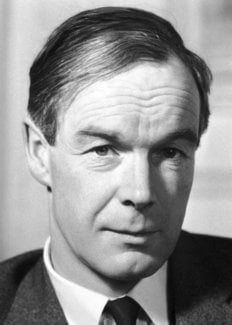Alan Hodgkin
Biographical

Alan Lloyd Hodgkin was born in Banbury, Oxfordshire, on February 5th, 1914. His parents were George Hodgkin (who died in Baghdad in 1918) and Mary (Wilson) Hodgkin, now Mrs. Lionel Smith. Alan Lloyd Hodgkin was educated at the Downs School, Malvern (1923-1927), Greshams School, Holt (1927-1932), and Trinity College, Cambridge (1932-1936). His grandfather, Thomas Hodgkin, and uncle, Robin Hodgkin, were historians and to begin with Alan hesitated between history and science. However, he was strongly interested in natural history and that decided him to take up biology and chemistry. After he had become a scholar at Trinity, his future zoology teacher, Carl Pantin, advised him to learn as much mathematics and physics as he could. This was good, if painful, advice which has kept him busy ever since. As an undergraduate he started some rather amateur experiments on frog nerve and continued this line for several years, first as a research scholar and later as a fellow of Trinity. At that period the high table of Trinity included an astonishing array of scientific talent, and Hodgkin found it inspiring if sometimes daunting to meet people like J. J. Thomson, Rutherford, Aston, Eddington, Hopkins, G. H. Hardy and Adrian. In the Physiological Laboratory he learnt about cable-theory from Rushton and about amplifiers from Matthews, Grey Walter and Rawdon-Smith.
A. V. Hill, who refereed his fellowship thesis, had lent a copy to Gasser and this resulted in an invitation to work in the latter’s laboratory at the Rockefeller Institute in New York. During that period (1937-1938) Hodgkin spent several weeks with K. S. Cole at Woods Hole and there he learnt how to dissect squid axons. He returned to Cambridge in 1938 and in the following year started a collaboration with A. F. Huxley, whom he had the good fortune to teach.
During the first few months of the war Hodgkin worked on aviation medicine with Matthews at Farnborough and from February 1940 to July 1945 in various parts of England on airborne radar. The project with which he was most concerned was the development of a scanning and display system for a 10-cm detection system in night-fighters.
After the war Hodgkin returned to Cambridge where he held a teaching post in the Physiology Laboratory; A. F. Huxley returned a few months later and they continued the collaboration which started before the war. R. D. Keynes joined them a year later and there was soon a small group interested in ionic mechanisms in living cells. Lord Adrian greatly assisted the progress, partly by lightening the teaching load and partly by arranging with the Rockefeller Foundation for a generous grant to support the work; later help was received from other bodies, particularly the Nuffield Foundation and the Royal Society. Most of the experiments on giant nerve fibres had to be done at a Marine Station, and since 1947 Hodgkin has usually spent two or three months each year at the Laboratory of the Marine Biological Association, Plymouth, where he has received much help from the director and the staff of that laboratory.
Professor Hodgkin was elected to a fellowship of the Royal Society in 1948 and in 1951 became a Foulerton Research Professor of the Royal Society. He served on the Royal Society Council from 1958-1960 and on the Medical Research Council from 1959-1963; he was foreign secretary of the Physiological Society from 1961-1967. In 1970 he was appointed John Humphrey Plummer Professor of Biophysics. He has been President of the Marine Biological Association since 1966, and President of the Royal Society since December 1970. In 1971 he was appointed Chancellor of Leicester University.
Among the honours and awards which have been given to Prof. Hodgkin the following might be mentioned: Royal Medal of the Royal Society, 1958; Copley Medal of the Royal Society, 1965; Member of the Royal Danish Academy of Sciences, 1964; Foreign Member of the American Academy of Arts and Sciences and of the American Philosophical Society; Member of the Deutsche Akademie «Leopoldina» Honorary Fellow, Indian National Science Academy; Hon. M. D. of the Universities of Berne and Louvain; Hon. D.Sc. of the universities of Sheffield, Newcastle, E. Anglia, Manchester, Leicester and London. He was made a KBE in the New Years’ Honours 1972.
While at the Rockefeller Institute in 1938 Hodgkin met Peyton Rous, the distinguished pathologist, and he got to know his family. His daughter, Marion Rous, and Alan Lloyd Hodgkin were married in 1944, while he was on a brief war-time visit to America. They have lived in Cambridge since 1945 and have three daughters and one son. Mrs. M. R. Hodgkin is Children’s Book Editor at Macmillan Publishing Company. His eldest daughter, Sarah (Mrs. R. Hayes), is married and has worked in publishing with Gollancz Ltd. His second daughter, Deborah, is a research student in Psychology at University College London. His son, Jonathan works in Molecular Biology at Cambridge, and his youngest daughter, Rachel, is also at Cambridge reading English.
Hodgkin’s favourite recreations include travel and fishing.
This autobiography/biography was written at the time of the award and first published in the book series Les Prix Nobel. It was later edited and republished in Nobel Lectures. To cite this document, always state the source as shown above.
For more updated biographical information, see:
Hodgkin, Alan Lloyd. Chance & Design: Reminiscences of Science in Peace and War. Cambridge University Press, Cambridge, 1992.
Alan L. Hodgkin died on December 20, 1998.
Nobel Prizes and laureates
Six prizes were awarded for achievements that have conferred the greatest benefit to humankind. The 14 laureates' work and discoveries range from quantum tunnelling to promoting democratic rights.
See them all presented here.
